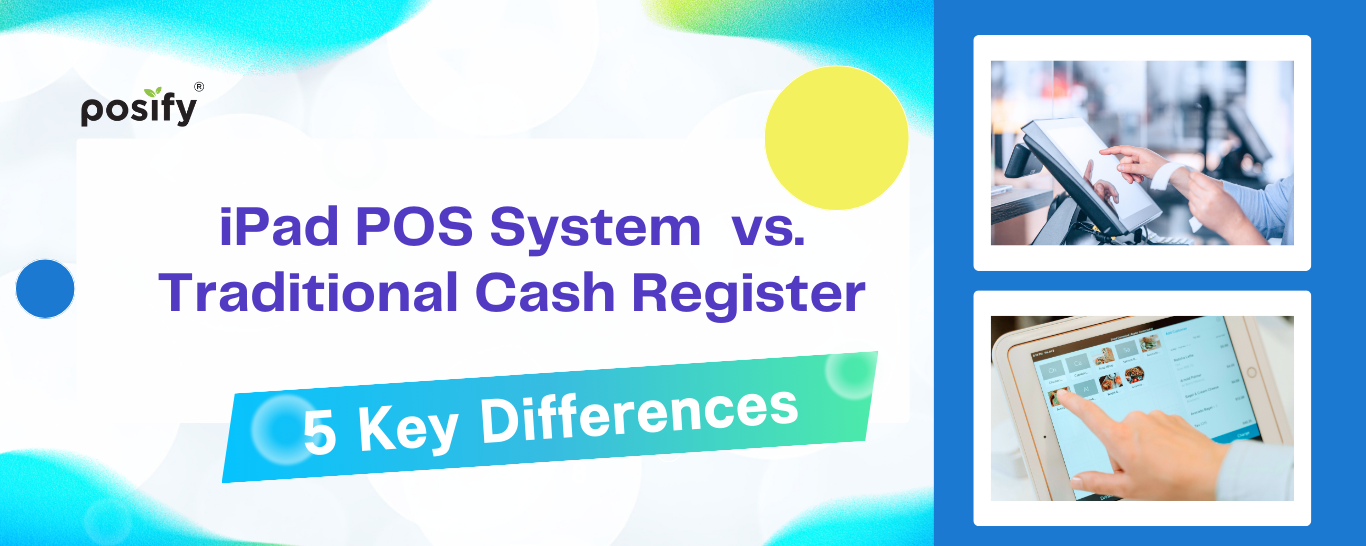iPad POS System vs. Traditional Cash Register: 5 Key Differences Explained

In the modern retail industry, the checkout system is not just a tool for completing transactions but also a crucial hub for business management. Traditionally, cash registers have been essential equipment in nearly every store, serving as the cornerstone of retail operations for decades. However, with rapid technological advancements, the widespread use of mobile devices, and increasingly diverse consumer demands, traditional cash registers face unprecedented challenges. At this juncture, the emergence of iPad POS systems offers merchants more versatile and flexible options. Especially amid the trend toward digital transformation, more businesses are embracing this innovative solution.
This article will analyze the key differences between iPad POS systems and traditional cash registers from five core perspectives, helping retailers comprehensively compare aspects such as functionality, cost, usability, data capabilities, and flexibility. This will provide you with a clearer and more complete understanding when choosing a checkout system.
Functionality Expansion: From Basic Checkout to Comprehensive Business Management
The greatest advantage of traditional cash registers lies in their simplicity, primarily responsible for quick checkout and cash handling. The system design is hardware-oriented with fixed, clear operating steps, suitable for high-frequency but straightforward sales environments. While this design is stable and reliable, its functional expansion is limited. To manage inventory, analyze sales data, or track customer activities, merchants usually need to integrate third-party hardware and software, leading to a cumbersome and difficult-to-integrate overall system.
The iPad POS system was developed to solve these issues, offering multiple key advantages. Leveraging powerful software platforms and cloud technology, it not only incorporates core functions of traditional cash registers but also integrates inventory management, customer relationship management (CRM), marketing promotions, and reporting analysis. Merchants can easily manage products, set up loyalty points, and create promotional campaigns via an intuitive interface. It also directly connects to online stores and delivery platforms, creating a seamless online-to-offline sales experience. This robust functional expansion helps merchants transform from a single sales point into a smart management platform, enhancing overall operational efficiency and competitiveness.
Cost Structure: One-Time Investment vs. Continuous Optimization
Regarding costs, traditional cash registers are characterized by “pay upfront for hardware, then use the service.” Merchants must make a one-time, higher equipment payment. The hardware generally has a long lifespan with relatively low maintenance costs, and software functions tend to be fixed versions, mostly locally deployed, lacking flexibility and real-time upgrade capability. However, when business needs change or hardware ages, upgrading or replacing equipment becomes costly and often risks operational interruptions.
In contrast, cloud-based iPad POS systems adopt a “lightweight hardware, subscription-based software” model. The initial hardware investment is lower, and merchants pay regular software subscription fees via a SaaS model, enjoying continuous system upgrades, expanded features, and technical support. This cloud POS system eliminates complex local server setup and maintenance, reduces reliance on IT staff, and further lowers total cost of ownership. Moreover, cloud POS supports multi-terminal and multi-store real-time synchronization, improving operational efficiency and data management flexibility.
In summary, traditional cash registers suit merchants with conservative capital, stable needs, and limited IT support, while cloud-based iPad POS systems and SaaS services better fit modern enterprises seeking flexible scalability, technological innovation, and operational agility.
Chat with our expert team via WhatsApp today to learn more!
User Experience and Training Costs: Intuitive Operation, Fast Learning
Traditional cash registers operate mainly through physical buttons and fixed interfaces, often designed with a function-heavy approach lacking user-friendliness. This design creates a higher learning barrier for new staff and longer training periods, especially in retail environments with high employee turnover, increasing labor management costs and the risk of operational errors. The rigid interface limits flexibility and efficiency during transactions.
iPad POS systems use the iPad as the terminal, featuring touch screens and graphical interfaces with operation logic similar to smartphones, fitting modern users’ digital habits. This design significantly reduces new employee learning curves, enabling quick onboarding while allowing experienced staff to use various functions more flexibly, boosting overall operational efficiency.
In today’s digital wave, excellent user experience is a vital competitive factor. iPad-based POS systems not only save substantial training and labor management costs but also enhance overall service quality and brand image with their intuitive, user-friendly interfaces, helping merchants stand out in a fierce market.
Data and Reporting Capabilities: Real-Time Insights for Smart Decisions
Traditional cash registers mainly produce data limited to daily transaction records, usually stored on paper or in simple electronic formats, lacking systematic data analysis tools. Merchants wanting to deeply analyze data must invest extra time and manpower, restricting data insight immediacy and accuracy.
Conversely, iPad POS systems feature powerful real-time data processing and report generation. Merchants can view sales trends, best-selling items, inventory status, and customer behavior anytime within the system and make flexible adjustments accordingly. The system supports multi-dimensional customizable reports, enabling data-driven decisions from daily operations to long-term strategy, improving management effectiveness.
More importantly, cloud technology allows merchants to monitor operations remotely anytime, anywhere, achieving real-time and convenient management. Data-driven management has become essential for enhancing competitiveness and customer loyalty in retail.
Mobility and Flexibility: Breaking Spatial Limits for Diverse Applications
The hardware nature of traditional cash registers requires fixed placement at checkout counters, limiting flexible use of store space and making it hard to meet diverse modern retail scenarios. This limitation is especially apparent in food delivery, pop-up markets, outdoor events, and other trends.
One of the biggest advantages of iPad POS lies in its high mobility. Thanks to the lightweight tablet hardware and wireless network connectivity, merchants can use it anywhere inside the store or even take the checkout point outdoors to complete sales anytime, anywhere. This not only improves customer shopping convenience but also helps merchants expand new sales channels and service models.
Additionally, iPad POS systems usually support multiple payment methods—from credit cards and mobile payments to e-wallets—catering to diverse payment habits and further enhancing the consumer experience.
.png)
Conclusion: Smart Choices Shape the Future of Retail
The comparison between iPad POS and traditional cash registers is more than a hardware upgrade; it reflects retail’s shift from a “hardware-centric” to a “data- and service-centric” model. Both have merits, and the key lies in whether merchants clearly understand their business needs, growth directions, and management strategies.
Traditional cash registers remain competitive in stable environments with one-time investments, but with rapid market and consumer habit changes, iPad POS systems with flexible scalability, cloud data capabilities, and excellent user experience are becoming the preferred choice for many retailers.
Retailers should move beyond single-device thinking and select checkout systems that support long-term development, enhance customer value, and improve operational efficiency. Only then can they stay ahead in an ever-changing market and create their own new retail future.






